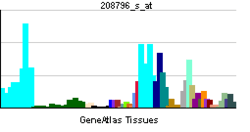CCNG1
| Cyclin G1 | |||||||||||||
|---|---|---|---|---|---|---|---|---|---|---|---|---|---|
| Identifiers | |||||||||||||
| Symbols | CCNG1 ; CCNG | ||||||||||||
| External IDs | OMIM: 601578 MGI: 102890 HomoloGene: 2995 GeneCards: CCNG1 Gene | ||||||||||||
| |||||||||||||
| RNA expression pattern | |||||||||||||
 | |||||||||||||
| More reference expression data | |||||||||||||
| Orthologs | |||||||||||||
| Species | Human | Mouse | |||||||||||
| Entrez | 900 | 12450 | |||||||||||
| Ensembl | ENSG00000113328 | ENSMUSG00000020326 | |||||||||||
| UniProt | P51959 | P51945 | |||||||||||
| RefSeq (mRNA) | NM_004060 | NM_009831 | |||||||||||
| RefSeq (protein) | NP_004051 | NP_033961 | |||||||||||
| Location (UCSC) | Chr 5: 162.86 – 162.87 Mb | Chr 11: 40.75 – 40.76 Mb | |||||||||||
| PubMed search | |||||||||||||
Cyclin-G1 is a protein that in humans is encoded by the CCNG1 gene.[1][2][3]
Function
The eukaryotic cell cycle is governed by cyclin-dependent protein kinases (CDKs) whose activities are regulated by cyclins and CDK inhibitors. The protein encoded by this gene is a member of the cyclin family and contains the cyclin box. The encoded protein lacks the protein destabilizing (PEST) sequence that is present in other family members. Transcriptional activation of this gene can be induced by tumor protein p53. Two transcript variants encoding the same protein have been identified for this gene.[3]
Interactions
CCNG1 has been shown to interact with:
References
- ↑ Endo Y, Fujita T, Tamura K, Tsuruga H, Nojima H (Mar 1997). "Structure and chromosomal assignment of the human cyclin G gene". Genomics 38 (1): 92–5. doi:10.1006/geno.1996.0598. PMID 8954786. Check date values in:
|year= / |date= mismatch(help) - ↑ Bates S, Rowan S, Vousden KH (Nov 1996). "Characterisation of human cyclin G1 and G2: DNA damage inducible genes". Oncogene 13 (5): 1103–9. PMID 8806701.
- ↑ 3.0 3.1 "Entrez Gene: CCNG1 cyclin G1".
- ↑ 4.0 4.1 4.2 Zhao L, Samuels T, Winckler S, Korgaonkar C, Tompkins V, Horne MC et al. (Jan 2003). "Cyclin G1 has growth inhibitory activity linked to the ARF-Mdm2-p53 and pRb tumor suppressor pathways". Mol. Cancer Res. 1 (3): 195–206. PMID 12556559.
- ↑ Okamoto K, Kamibayashi C, Serrano M, Prives C, Mumby MC, Beach D (Nov 1996). "p53-dependent association between cyclin G and the B' subunit of protein phosphatase 2A". Mol. Cell. Biol. 16 (11): 6593–602. PMC 231661. PMID 8887688.
Further reading
- Horne MC, Goolsby GL, Donaldson KL, Tran D, Neubauer M, Wahl AF (1996). "Cyclin G1 and cyclin G2 comprise a new family of cyclins with contrasting tissue-specific and cell cycle-regulated expression". J. Biol. Chem. 271 (11): 6050–61. doi:10.1074/jbc.271.11.6050. PMID 8626390.
- Okamoto K, Kamibayashi C, Serrano M, Prives C, Mumby MC, Beach D (1996). "p53-dependent association between cyclin G and the B' subunit of protein phosphatase 2A". Mol. Cell. Biol. 16 (11): 6593–602. PMC 231661. PMID 8887688.
- Kanaoka Y, Kimura SH, Okazaki I, Ikeda M, Nojima H (1997). "GAK: a cyclin G associated kinase contains a tensin/auxilin-like domain". FEBS Lett. 402 (1): 73–80. doi:10.1016/S0014-5793(96)01484-6. PMID 9013862.
- Kato MV (1999). "The mechanisms of death of an erythroleukemic cell line by p53: involvement of the microtubule and mitochondria". Leuk. Lymphoma 33 (1-2): 181–6. doi:10.3109/10428199909093740. PMID 10194136.
- Reimer CL, Borras AM, Kurdistani SK, Garreau JR, Chung M, Aaronson SA et al. (1999). "Altered regulation of cyclin G in human breast cancer and its specific localization at replication foci in response to DNA damage in p53+/+ cells". J. Biol. Chem. 274 (16): 11022–9. doi:10.1074/jbc.274.16.11022. PMID 10196184.
- Bennin DA, Don AS, Brake T, McKenzie JL, Rosenbaum H, Ortiz L et al. (2002). "Cyclin G2 associates with protein phosphatase 2A catalytic and regulatory B' subunits in active complexes and induces nuclear aberrations and a G1/S phase cell cycle arrest". J. Biol. Chem. 277 (30): 27449–67. doi:10.1074/jbc.M111693200. PMID 11956189.
- Jordan-Sciutto KL, Morgan K, Bowser R (1999). "Increased Cyclin G1 Immunoreactivity During Alzheimer's Disease". J. Alzheimers Dis. 1 (6): 409–417. PMID 12214116.
- Zhao L, Samuels T, Winckler S, Korgaonkar C, Tompkins V, Horne MC et al. (2003). "Cyclin G1 has growth inhibitory activity linked to the ARF-Mdm2-p53 and pRb tumor suppressor pathways". Mol. Cancer Res. 1 (3): 195–206. PMID 12556559.
- Baek WK, Kim D, Jung N, Yi YW, Kim JM, Cha SD et al. (2003). "Increased expression of cyclin G1 in leiomyoma compared with normal myometrium". Am. J. Obstet. Gynecol. 188 (3): 634–9. doi:10.1067/mob.2003.140. PMID 12634633.
- Li JQ, Kubo A, Wu F, Usuki H, Fujita J, Bandoh S et al. (2003). "Cyclin B1, unlike cyclin G1, increases significantly during colorectal carcinogenesis and during later metastasis to lymph nodes". Int. J. Oncol. 22 (5): 1101–10. doi:10.3892/ijo.22.5.1101. PMID 12684677.
- Ohtsuka T, Jensen MR, Kim HG, Kim KT, Lee SW (2004). "The negative role of cyclin G in ATM-dependent p53 activation". Oncogene 23 (31): 5405–8. doi:10.1038/sj.onc.1207693. PMID 15077171.
- Rual JF, Venkatesan K, Hao T, Hirozane-Kishikawa T, Dricot A, Li N et al. (2005). "Towards a proteome-scale map of the human protein-protein interaction network". Nature 437 (7062): 1173–8. doi:10.1038/nature04209. PMID 16189514.
- Seo HR, Lee DH, Lee HJ, Baek M, Bae S, Soh JW et al. (2006). "Cyclin G1 overcomes radiation-induced G2 arrest and increases cell death through transcriptional activation of cyclin B1". Cell Death Differ. 13 (9): 1475–84. doi:10.1038/sj.cdd.4401822. PMID 16322753.
- Gramantieri L, Ferracin M, Fornari F, Veronese A, Sabbioni S, Liu CG et al. (2007). "Cyclin G1 is a target of miR-122a, a microRNA frequently down-regulated in human hepatocellular carcinoma". Cancer Res. 67 (13): 6092–9. doi:10.1158/0008-5472.CAN-06-4607. PMID 17616664.